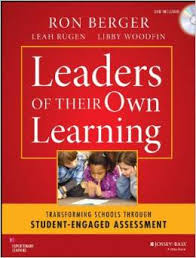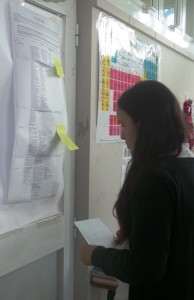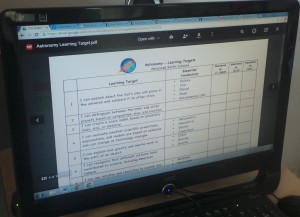The Learning Target Experiment Part I
At The Community for Learning (TCFL), we’re constantly working to engage our students in class, to motivate them and help them become self-directed learners. So, when we discovered the book Leaders of Their Own Learning by Ron Berger, Leah Rugen, and Libby Woodfin, the title jumped out at us and we were intrigued. According to the authors, “This system has unique power – it puts students at the center and students in the lead. It is more than a framework for evaluation. It is a framework for motivation and a framework for achievement.” Curious, we began a book study with our coordinators in both elementary and secondary school to see if there were any ideas we could take away and use to improve our school (educators are like crows – we steal every bright and shiny idea we find). However, by the end of our study, we decided that we didn’t want to just adopt a few ideas, we wanted to implement everything in the book. And so, last year, our journey began.
The first chapter in the book introduced “learning targets,” which sound simple enough. Take an objective, simplify it into a bite-size chunk, write it in language students can understand, and tack on the words “I can.” For example: “I can write a learning target.” During our last trimester of the school year, we decided to give learning targets a try before using them school-wide.
Our Science coordinator and teacher, Dennis, jumped in with enthusiasm. Would he introduce a few learning targets, see how it went, and then go further? No, not Dennis. He’s a risk-taker, and slow and steady is simply not his style. He decided to allow his 12th grade students to have a look at what they still needed to cover in the curriculum, set their own learning targets, and come up with a project that would allow them to meet their goals and showcase their learning. I should mention that our 12th graders, ready to fly the coop, were a particularly unmotivated group of students at that point. I was a bit worried about how they would do.
“Are you sure you want to start with this group, Dennis?”
His reply: “Who better to start with? If it works with these kids, it will work with anyone.”
Okay then.
As his experiment began, I walked into the classroom to find kids deciding what interested them, creating learning targets, designing projects, and writing checklists to show how they’d know they had mastered the learning target. Some students were working in pairs or small groups, brainstorming ideas. Paulina was explaining how to develop a series of learning targets to Fernando. Rosa was at the curriculum posted on the wall, looking at the areas that she still needed to study in order to come up with her project.
I asked Leslie about what she was doing and she explained that she had looked at the curriculum and searched for topics that interested her. Then she began to think about how to formulate questions about the topic. At the moment, she was working on creating learning targets and thinking about how she’d prove that she’d mastered those targets. Asked how she felt about this kind of work, she answered, “It makes me feel motivated because I’m making the decisions. I get to decide what I choose to study and how to make my project.” (She was as self-motivated as Leaders of Their Own Learning said she would be.)
I asked her if doing this kind of work was scary and she said, “Not really, because Dennis is there to help us and answer any questions we have.”
Nicole responded to my questions, saying, “I really like this project because I get to choose what I’m learning and I’m in charge of the way I learn it. I’m doing research about something that really interests me.”
I told her that if I shared this idea with a group of teachers, some of them might say, “Some kids are lazy and won’t do anything.” What would she respond to that?
She said, “Well, I think that it’s a more motivating way to learn because it’s your own choice, so I think that kids would work more, not less. For instance, look at our class — everyone’s working and excited. Also, think about university – students get to study what they like, and they go much further.”
Dennis informed his students that next week they’d be setting up their learning schedule. They’d decide on the days they want to conference and when they want to take a quiz and a test. Nicole was curious about the time frame for mastering each of her learning targets, and Dennis let her know that she should focus on the first one, then move on to the next one. If she can only get to four learning targets, that’s fine, as long as she truly understands what she’s studying.
Fast forward four weeks. The students’ projects are amazing and every one of them has finished on time (even though this group is notorious for procrastination). All of them have mastered their learning targets. They’re enthusiastic, motivated, and they all feel successful.
During those four weeks, a few other teachers also did test runs of learning targets in their classrooms, with equally positive results. So we took the decision to go school-wide for the 2015-16 school year. In our August teacher training, we planned to introduce learning targets to the entire teaching staff and begin implementing them from Pre-K through 12th grade. Stay tuned for the next post to see how this school-wide initiative is going!




Leave a comment